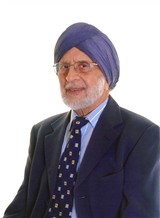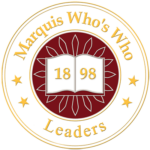
Occupation: Chemist (Retired)
During 1998-2006, while at Cambridge University, he was invited to serve on a multidisciplinary EPSRC funded committee of professionals selected from 15 United Kingdom universities for inter-communication on the latest research activities in their laboratories every six months. At Cambridge University (1998-2006) he is well known for his work on the decontamination of surgical instruments related to Creutzfeldt-Jakob Disease (vCJD), a fatal condition in humans thought to originate with Mad Cow disease, or bovine spongiform encephalopathy (BSE) identified in 1996. It affects around 1-2 per million people per year worldwide; in the USA there are ~300 cases per year. He worked with the British Department of Health and 20 leading universities and teaching hospitals to prevent any further human fatalities and to curb a disease that resulted in the destruction of thousands of cows, with severe impact to the British beef industry. This disease is transmitted by eating infected beef and is caused by conversion under certain conditions in due course of normal cellular prion protein (PrPc) present in the brain to disease associated prion (PrPsc) isoform. Cross-contamination by reprocessing of medical instruments after acute care was one of the main reasons for transmission of the disease in patients in hospitals. The sterilization procedures available at that time were satisfactory for normal prion but ineffective for abnormal infectious prion. A novel sensor called magnetic acoustic resonant sensor, was developed at our Institute to study in real time the binding of prion protein isoforms to stainless steel grades, plastics, optical glass and quartz used in the manufacture of surgical instruments and their desorption by a variety of chemical washing solutions, and by ultra-violet light plus ozone gas. These studies allowed us to issue firm guidelines on optimum cleaning, sterilization or disposal protocols for contaminated instruments. On multiple occasions, Dr. Sethi has been asked to represent the Institute of Biotechnology at Cambridge during the beginning of the academic year in deference to his seniority.
Education:
Postdoctoral Fellow, Imperial College London, England (1966-1970)
PhD in Physical Chemistry, Delhi University (1966)
Research Fellow, Delhi University (1962-1966)
MS in Chemistry, Delhi University (1962)
BS in Chemistry, Delhi University, with Honors (1960)
Certifications:
Chartered Chemist
Career:
Consultant, RS Consulting, Northamptonshire, United Kingdom (2006-2008)
Senior Research Associate, Institute of Biotechnology, University of Cambridge, Cambridge, England (1998-2006)
Chief Chemist, GEC-Marconi Material Technology, Ltd., Northamptonshire, United Kingdom (1990-1998)
Chief Chemist, Plessey Company, Ltd., Northamptonshire, United Kingdom (1984-1990)
Senior Principal Scientist, Plessey Company, Ltd., Northamptonshire, United Kingdom (1976-1984)
Principal Scientist, Plessey Company, Ltd., Northamptonshire, United Kingdom (1973-1976)
Senior Scientist, Plessey Company, Ltd., Northamptonshire, United Kingdom (1970-1973)
Career Related:
Industrial Adviser, School of Natural and Environmental Sciences, Coventry University (1993-1996); Joint Project, Plessey Company, Ltd., Pilikington, United Kingdom and Scientific Method, United Kingdom (1993-1996); Industrial Partner, Brunel University London, West London, United Kingdom (1992-1996); University of Cambridge (1985-1996); Industrial PhD Supervisor (1985-1994); Industrial Partner, Institute of Biotechnology, University of Cambridge (1984-1996); Joint Project, Plessey Company, Ltd., Laboratory of the Government Chemist, Sponsored by Her Majesty Custom and Excise, United Kingdom (1984-1991); Joint Project, Plessey Company, Ltd., Dr. D. Bands, Guy’s and St. Thomas Hospital, London, United Kingdom (1984-1988); Joint Project, Plessey Company, Ltd., British Telecom, Hull, Durham, Lancaster Universities, United Kingdom and Department of Trade & Industry, United Kingdom (1984-1986); Joint Project, Plessey Company, Ltd., Engineering Department, University of Oxford, Oxford (1978-1981); Joint Project, Plessey Company, Ltd., Rolls-Royce (Molten Salt Electro-Coating Super-Alloy RB211 Turbine Blades at Plessey, Used in its Engines for Military and Aerospace, to Increase Service Life), United Kingdom and Royal Air Force, United Kingdom (1976-1980); Joint Project, Plessey Company, Ltd., Work with Late Sir Nevill Mott, Noble Laureate at University of Cambridge (1976-1980); Worked with Some of the Most Prestigious Laboratories in the World Including the Lewis Research Center of NASA, U.S. Naval Research Laboratory, and Oak Ridge National Laboratory
Civic:
Member, Protocol Club for Executives, Northampton, United Kingdom (1972-Present)
Creative Works:
Co-author, “The Application of the Acoustic Spectrophonometer to Bimolecular Spectrometry: A Step Towards Acoustic ‘Fingerprinting,'” Journal of Molecular Recognition (2004); Co-author, “Planar Coil Excitation of Multifrequency Shear Wave Transducers,” Biosensors and Bioelectronics (2004); Co-author, “Detection of Acoustic Solitary Waves in Nonlinear Lithium Niobate Crystals,” Applied Physics Letters (2003); Co-author, “The Acoustic Spectrophonometer: A Novel Bioanalytical Technique Based on Multifrequency Acoustic Devises,” Analyst (2003); Co-author, “Hypersonic Evanescent Waves Generated with a Planar Spiral Coil,” Analyst (2003); Co-author, “Gigahertz Surface Acoustic Wave Probe for Chemical Analysis,” Analyst (2001); Co-author, “Adsorption of Prion Isoforms to Stainless Steel, Glass and Plastic Surfaces,” Part I, Towards Acoustic Finger Printing of Prion Protein, Abstract 80, Part II, Surface Reactions of Proteins on Glasses, Abstract 81, Part III, Adsorption of Proteins on Plastics, Abstract 82, Part IV, Decontamination of Surgical Instruments, Abstract 83, Proceedings of the Joint Funders TSE Workshop at the University of York, United Kingdom (2004); Co-author, “Adsorption of Prion Isoforms to Stainless Steel Surfaces: Implications for Surgical Decontamination Procedures,” Proceedings of the Joint Funders TSE Workshop at the Durham University, United Kingdom (2002); Co-author, “Immunodetection of Recombinant Prion Protein (rPr) in Binding to Surgical Steel,” Proceedings of the Joint Funders TSE Workshop at the Durham University, United Kingdom (2002); Author, Chapter, “Special Polymers for Electronics and Optoelectronics” (1995); Co-author, “Selective Membrane Love Wave Biosensors,” Proceedings of the First UK National Symposium on Nanotechnology in Medicine and Biosensors, Hammersmith Hospital, Imperial College Campus, London, United Kingdom (1994); Author, “Transducer Aspects of Biosensors,” Biosensor and Bioelectronics (1994); Co-author, “Electrochemical Biosensors,” Proceedings of the Meeting on Biosensors, Instrument Science & Technology Group, Institute of Physics, London, England (1991); Co-author, “Enzyme Entrapment in Conducting Polymers: Applications in Amperometric Biosensors,” Symposium on New Electrochemical Sensors, 150th Anniversary Annual Chemical Congress, Royal Society of Chemistry, Imperial College London, United Kingdom (1991); Co-author, “Multianalyte Minature Conductance Biosensor,” Analytica Chimica Acta (1990); Co-author, “An Improved Silicon Chip Based Biosensor,” Proceedings of the Third Meeting on Chemical Sensors, Cleveland, Ohio (1990); Co-author, Invited Paper, “Electrochemical Microbiosensors,” Institute of Electrical Engineers Colloquium on Microsensors, UMIST, Manchester, United Kingdom (1990); Co-author; “Multianalyte Microelectronic Biosensors,” Sensors and Actuators, B1 (1990); Co-author; “An Improved Micro-Conductimetric Biosensor,” International Symposium on Electro-Analysis in Biomedical, Environmental and Industrial Sciences, Royal Society of Chemistry, Loughborough University, Leicester, United Kingdom (1990); Author, “Electrochemical Sensors on Silicon Chip,” British Process Silicon for Biosensors Fabrication, Industry News, Semiconductor International (1989); Author, “Silicon Processing in the Fabrication of Biosensors,” Semiconductor International Conference, National Exhibition Centre, Birmingham, United Kingdom (1989); Co-author, “Chromatographic Micro-Separation and Detection on a Silicon Wafer,” Proceedings of Eurosensors III, Fifth International Conference on Solid State Sensors and Actuators, Montreaux, Switzerland (1989); Co-author, “An Improved Micro-Conductimetric Sensor,” Proceedings of Eurosensors II, Fourth Symposium Sensors and Actuators, University of Twente, Enschede, The Netherlands (1988); Co-author, “Microelectronic Biosensor (Conductimetric) Based on Silicon Chip,” World First Reported, Biosensors (1987-1988); Co-author, “A Microelectronic Biosensor Device,” Proceeding Eurosensors I, Fourth Symposium on Sensors and Actuators, Cambridge, United Kingdom (1987); Author, “Electrodeposition from Molten Salts,” The East Midland Branch of the Institute of Metal Finishing, United Kingdom (1982); Author, “Improvements in Electrical Properties of Anodized Aluminium Oxide by Ion Implantation,” The Electrochemical Society Inc. Fall Meeting, Pittsburgh, PA (1978); TSE Workshops Jointly Organized by Biotechnology and Biological Sciences Research Council, Department for Environment, Food and Rural Affairs, Department of Health, Food Standard Agency and Medical Research Council, United Kingdom
Achievements:
He is co-author for creating the world’s first reported microelectronic biosensor based on a silicon chip; written over 200 Technical Reports for Various Government Agencies and Contributed 40 Articles to Professional Journals. First two patents produced about a 50% increase in profit on annual sale of several thousand electrolytic capacitors manufactured by Plessey, the first ever significant improvement for company after a decade; Listee, Who’s Who in Science and Engineering (25 Times); Listee, Who’s Who in the World (25 Times); Patentee in Field, 20 Patents Including Silicon Chips and Wafer-Based Biosensors, Optical Fibers, Electrolytes for Aluminum Electrolytic Capacitors and Improvements for Dielectric Film Technology Through Ion Implantation with 16 elements and Doping by Electrochemical Techniques, United States, Europe, Japan and United Kingdom.
Awards:
Recipient, Albert Nelson Marquis Lifetime Achievement Award (2017); Recipient, Ten Innovation Awards, Plessey Company, Ltd. (1976-1991); Recipient, Prize, Best Chemistry Postgraduate Lecture, Delhi University (1961)
Memberships:
Member, Multidisciplinary Engineering and Physical Sciences Research Council Funded Committee, United Kingdom (1998-2005); Fellow, Royal Society of Chemistry; Fellow, UK Parliament Society Link; Honorary Representative, UK Parliament Society Link; Past Member, The Electrochemical Society; Member, IUPAC; Member, Molten Salts Discussion Group; Member, Royal Society of Chemistry; Member, Analytical Division, Analytical Biosciences and Electroanalytical; Member, Faraday Division, Electrochemistry
Family:
Son of Attar Singh Sethi and Nikki Sethi
Married: Harbans (January 12, 1969)
Children: Janet; Rushmi
Grandchildren: One Grandson; Two Granddaughters
Six Brothers; Two Sisters
Hobbies:
Photography; Table Tennis; Listening to Classical Music; Gardening
Biography Sources:
Who’s Who in Science and Engineering – 2016-2017, 12th Edition (pub. 2016)
Who’s Who in Science and Engineering – 2011-2012, 11th Edition (pub. 2010)
Who’s Who in Science and Engineering – 2008-2009, 10th Edition (pub. 2007)
Who’s Who in Science and Engineering – 2006-2007, 9th Edition (pub. 2006)
Who’s Who in Science and Engineering – 2005-2006, 8th Edition (pub. 2004)
Who’s Who in Science and Engineering – 2003-2004, 7th Edition (pub. 2003)
Who’s Who in Science and Engineering – 2002-2003, 6th Edition (pub. 2001)
Who’s Who in Science and Engineering – 2000-2001, 5th Edition (pub. 1999)
Who’s Who in the World – 2016, 33rd Edition (pub. 2016)
Who’s Who in the World – 2015, 32nd Edition (pub. 2014)
Who’s Who in the World – 2014, 31st Edition (pub. 2013)
Who’s Who in the World – 2013, 30th Edition (pub. 2012)
Who’s Who in the World – 2012, 29th Edition (pub. 2011)
Who’s Who in the World – 2011, 28th Edition (pub. 2010)
Who’s Who in the World – 2009, 26th Edition (pub. 2008)
Who’s Who in the World – 2008, 25th Edition (pub. 2007)
Who’s Who in the World – 2007, 24th Edition (pub. 2006)
Who’s Who in the World – 2006, 23rd Edition (pub. 2005)
Who’s Who in the World – 2005, 22nd Edition (pub. 2004)
Who’s Who in the World – 2004, 21st Edition (pub. 2003)
Who’s Who in the World – 2003, 20th Edition (pub. 2002)
Who’s Who in the World – 2001, 18th Edition (pub. 2000)
Who’s Who in the World – 2000, 17th Edition (pub. 1999)
Who’s Who in the World – 1999, 16th Edition (pub. 1998)
Who’s Who in the World – 1998, 15th Edition (pub. 1997)
